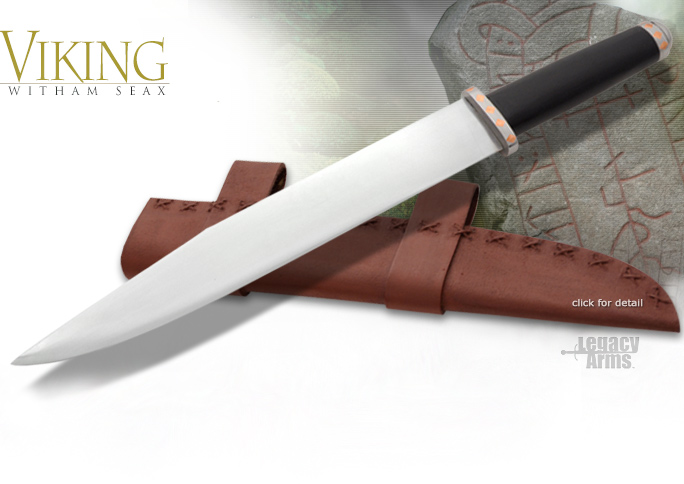WITHAM VIKING SEAX IP-704 LEGACY ARMS IP-704 LEGACY ARMS
The Generation2/Legacy Arms Witham Seax is based off a 10th century style and is a nice match to the Witham Viking Sword as they both share solid carbon steel pommels and cross guards with copper diamond inlays. The tempered blade is made of 5160 high carbon steel and measures over 12 inches long with a 5 inch grip. This massive Viking knife is full tang construction and the tang is peened over top the steel end cap of the handle. The grip is wood, and is wrapped in brown leather. Included is a hand cross-stiched brown leather scabbard which is double looped to hold the knife horizontal in authentic style. As with all Gen 2/Legacy Arms swords and daggers the Viking Small Seax has a peened pommel and is hand forged just like the originals. The IP-704 Witham Viking Seax is both a beast of a weapon and a handy utility knife for any Viking warrior on the row or on the go!

Read more on Functional Battle Ready Blades
|
|

• Overall length: 17-3/8"
• Blade length: 12-1/4"
• Grip Length: 5"
• Weight: 14.6 oz
• Edge: Sharp
• Point of Balance: 2-1/4"
• Blade Steel: 5160 high-carbon steel
• Blade Width: 38.9 mm
• Blade Thickness: 4.9 mm - 3.5 mm
• Pommel: Peened

Specs may vary slightly from piece to piece.
|
A scramseax (also seax ) was a type of Germanic single-edged knife. Scramseax seem to have been used for warfare and as a tool. They occur in a size range from 2.9" to 29.5". The larger ones (langseax) were probably weapons, the smaller ones (hadseax) tools, intermediate sized ones serving a dual purpose. Wearing a scramseax may have been indicative of freemanship. The scramseax was worn in a horizontal sheath at the front of the belt. Scram refers to food and seax to a blade (so, "food knife"). There is some debate about the authenticity of the longer word scramseax. The Saxons may have derived their name from seax (the implement for which they were known) in much the same way that the Franks were named for their francisca. This claim is largely supported by the appearance of scramaseaxes in early Saxon heraldry.
|
|
|